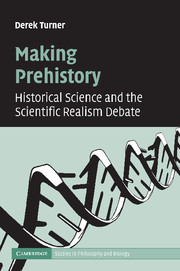Book contents
- Frontmatter
- Contents
- List of figures
- Acknowledgments
- Introduction
- 1 Asymmetries
- 2 The colors of the dinosaurs
- 3 Manipulation matters
- 4 Paleontology's chimeras
- 5 Novel predictions in historical science
- 6 Making prehistory: could the past be socially constructed?
- 7 The natural historical attitude
- 8 Snowball Earth in the balance
- Conclusion
- References
- Index
Conclusion
Published online by Cambridge University Press: 22 September 2009
- Frontmatter
- Contents
- List of figures
- Acknowledgments
- Introduction
- 1 Asymmetries
- 2 The colors of the dinosaurs
- 3 Manipulation matters
- 4 Paleontology's chimeras
- 5 Novel predictions in historical science
- 6 Making prehistory: could the past be socially constructed?
- 7 The natural historical attitude
- 8 Snowball Earth in the balance
- Conclusion
- References
- Index
Summary
Anyone familiar with the scientific realism debate knows that the main players – philosophers such as Richard Boyd, Michael Devitt, and Jarrett Leplin (on the realist side), and Arthur Fine, Larry Laudan, and Bas van Fraassen (on the other side) – have had relatively little to say about the scientific study of prehistory. I have tried to show that as a result of this omission, the realism debate has been skewed in several ways. First, realist arguments meant to establish the possibility of knowledge of unobservables have differential force depending on the kind of unobservables in question. These arguments usually involve some sort of inference to the best explanation. I have tried to show that they give less support to historical than to experimental realism. Second, there are problems concerning the scope of our knowledge of prehistory that do not arise in the context of experimental science. Local underdetermination problems are more common in historical than in experimental science, and novel predictive successes are also fewer and further between. Third, of the two leading varieties of non-realist philosophy of science, one of these (van Fraassen's constructive empiricism) leads to unacceptably radical skepticism when applied to prehistory, whereas Arthur Fine's natural ontological attitude can serve nicely as the basis for a philosophy of historical science – the natural historical attitude. I hope that my arguments for these claims help to move the discussion of scientific realism in a fruitful direction.
Information
- Type
- Chapter
- Information
- Making PrehistoryHistorical Science and the Scientific Realism Debate, pp. 204 - 206Publisher: Cambridge University PressPrint publication year: 2007
